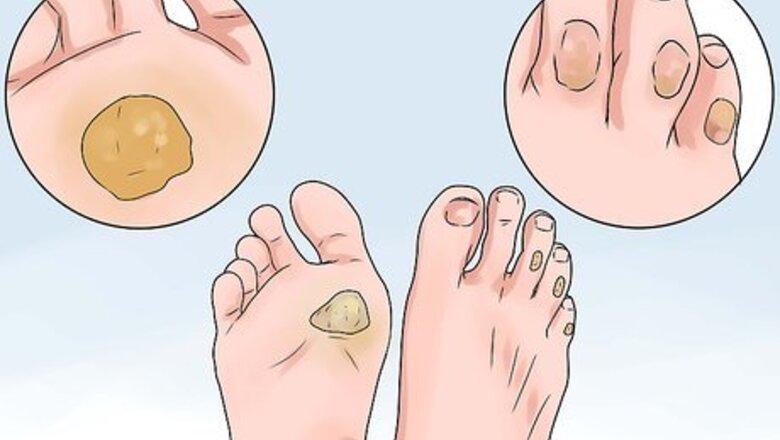
views
Treating Corns and Calluses at Home

Differentiate between a corn and a callus. Corns and calluses are not the same thing, therefore the treatment approaches are different. A corn can develop between the toes, has a core, and can be quite painful. Corns also develop along the tops of the toes, most often located just above a joint in the toe. Corns are categorized as hard, soft, or periungual. A hard corn most commonly develops on the top of the toe and over a bone joint. A soft corn develops between the toes, usually between the fourth and fifth toes. A periungual corn is less common, and occurs along the edge of a nailbed. A core is not always present, but is usually found at the center of the corn. The core consists of thick and dense skin tissue. The core of the corn points inward and often presses on a bone or nerve which causes it to be quite painful. A callus does not have a core, and is a broader area that is made of evenly distributed thicker tissue. Calluses are not usually painful, although they can be uncomfortable. Calluses usually develop on the bottom of the foot and just beneath the toe area. Calluses can also develop on the hands, usually on the palm side and just under the fingers. Both corns and calluses are caused by friction and pressure.
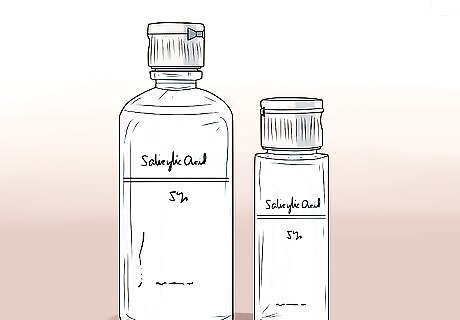
Use over-the-counter remedies. Salicylic acid is the most common ingredient found in over-the-counter products used to treat corns and calluses. The use of over-the-counter products is helpful in removing corns and calluses, but their use is more effective when combined with general measures to take care of the skin. Take steps to treat the immediate problem, but be sure to correct the problem causing the friction or pressure.
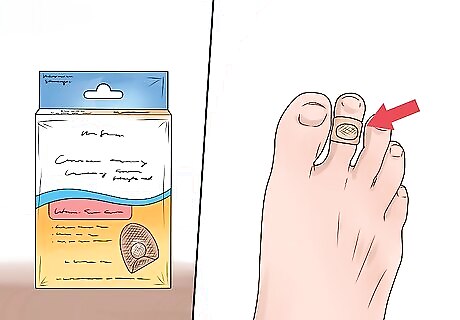
Apply salicylic acid pads to remove a corn. Salicylic acid corn remover pads are available without prescription in strengths as strong as 40%. Soak the foot in warm water for about five minutes to soften the tissue. Dry the foot and toes thoroughly before applying the pads. Take care not to apply the pad against healthy skin tissue. Most products recommend repeating the procedure every 48 to 72 hours, for up to 14 days, or until the corn is removed. Salicylic acid is classed as a keratolytic agent. This means it helps to bring added moisture to the area while working to soften and dissolve skin tissue. Salicylic acid can be harmful to healthy tissue. Follow the instructions on the product or in the product literature. Do not use if you are allergic to salicylic acid products. Avoid getting salicylic acid products in your eyes, nose, or mouth, and do not use on any other area of the body without instructions from your doctor. Rinse any areas accidentally exposed to salicylic acid with water immediately. Keep salicylic acid products stored in a safe manner, away from children and pets.
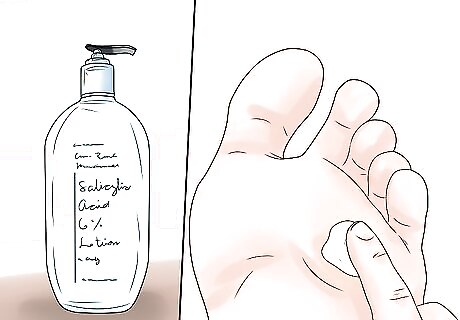
Use salicylic acid for calluses. Salicylic acid comes in a variety of forms and a multitude of strengths. Foams, lotions, gels, and pads are available that can be used to treat callused areas on your foot. Each product has unique application instructions. Follow the direction on the product or in the product literature to effectively use salicylic acid products to get rid of calluses.

Use topical products with 45% urea. Other than treatment with salicylic acid, other products are available over-the-counter that may be helpful. Products that contain 45% urea can be used topically as keratolytics to help soften and remove unwanted tissue, including corns and calluses. Follow the directions provided on the product label or contained in the product literature. Routine directions for using 45% topical urea products include twice daily applications until the condition has resolved. Do not ingest topical urea products, and do not get them in your eyes, nose, or mouth. Keep the products away from children and pets. If swallowed, call 911, call a poison control center, or seek emergency medical attention the fastest way possible.
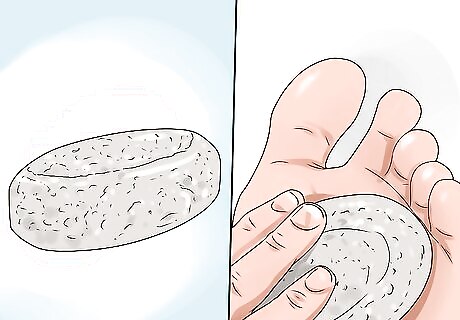
Use a pumice stone. For callused areas, using a pumice stone or file designed for the foot, can help to get rid of the hardened areas of skin. They're especially helpful on broad, callused areas, like the heel or the bottom of your feet. This can also be used for unwanted calluses that form on the hands. Using a device like a pumice stone or file helps to remove layers of dead skin. Take care not to file away healthy tissue. Doing so can lead to further irritation and possibly infection if the healthy skin is broken. File away layers of thickened and hard tissue before you apply medication.
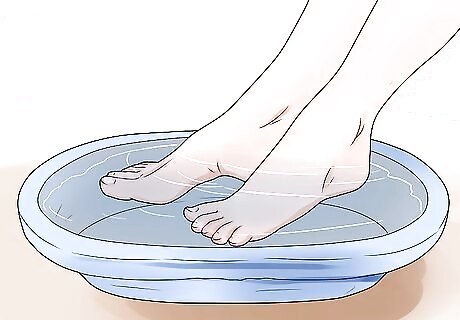
Soak your feet. Soaking your feet in warm water helps to soften the thickened areas of tissue for both corns and calluses. For unwanted calluses on your hands, soaking the area can help to soften the tissue just as it does for your feet. Dry your feet or hands thoroughly after soaking. While your skin tissue is soft after soaking, proceed with using your pumice stone or file.. Even if you don’t have time to soak your feet or hands every day, use the pumice stone or file just after getting out of your bath or shower.
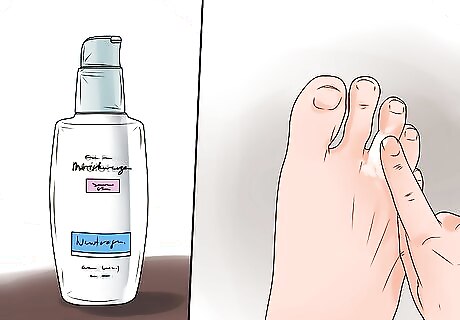
Keep your skin moist. Apply moisturizers to your feet and hands to help keep the tissues soft. This can make it easier to remove the hardened thick areas of skin with a pumice stone or file, as well as help to prevent the formation of corns and calluses. Since the skin on your feet is very thick, use a thick lotion to ensure it's able to penetrate deep enough to soften your feet.
Seeking Medical Attention
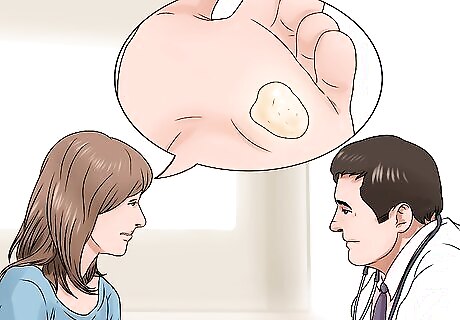
Pursue medical help in treating the condition. If you have a callus or corn that's deeply seated in one area, it's probably best to have that treated at a podiatrist's office. Also, if you have diabetes, you are at greater risk of serious foot problems partly caused by changes in circulation to your extremities, so it's especially important to see a doctor. Medical conditions like diabetes, peripheral neuropathy, and any other condition that interferes with normal blood flow, warrant medical help to treat corns and calluses. Talk to your doctor before treating your corns or calluses at home.

Ask your doctor for instructions if the areas are large and painful. While corns and calluses rarely fall in the category of a medical emergency, sometimes the areas are very large and quite painful. Seeking help from your doctor is the safest and most effective way to proceed with treatment. Some corns and calluses are resistant to the available over-the-counter treatment options. Ask your doctor about prescription strength products or procedures that may be helpful. Your doctor can help by performing some in-office procedures to improve the condition. Using a scalpel or other tool available in the medical office, your doctor can help to trim away large areas of excess and hardened skin. Do not attempt to trim very thick areas of hardened skin at home. This may lead to more irritation, bleeding, and possible infection.
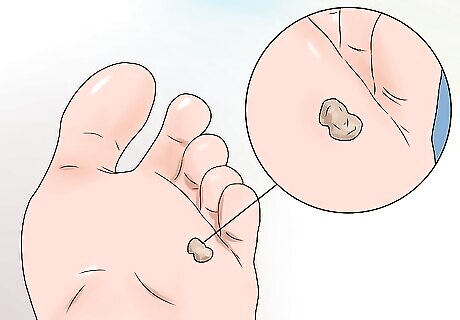
Look for warts. In addition to corns and calluses, sometimes warts are part of the problem. Your doctor can help determine if warts, or any other skin condition, is involved and recommend the best treatment approach.
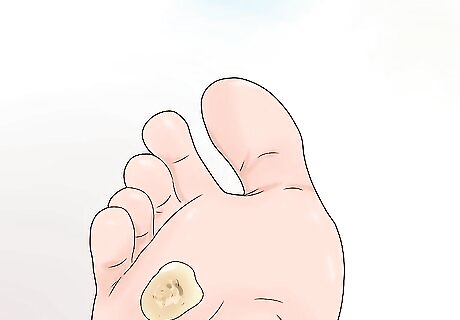
Watch for signs of infection. Very rarely, the corns or calluses may become infected. See you doctor as soon as possible if any area of your foot or hand is red, swollen, feels warm to the touch, or is more tender than normal.
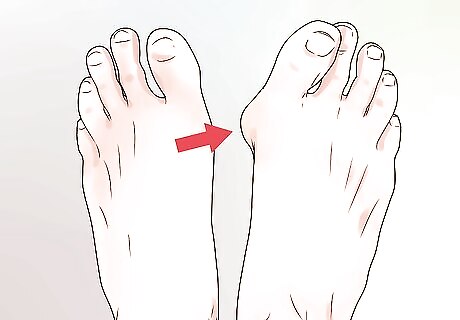
Consider foot conditions that cause misalignment. Some people have deformities in their feet that cause them to have repeated problems, including recurrent problems with corns and calluses. Your doctor may refer you to a podiatrist for treatment. Some conditions that may be contributing to the problems you are having with corns and calluses include hammer toe, bone spurs, lower than normal natural arches, and bunions. Many of these conditions can be corrected by wearing inserts or specially designed footwear. In rare cases, surgery may be warranted.
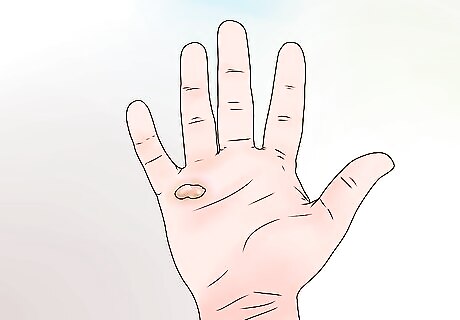
Watch for complications on your hands. When calluses develop from a source of friction or pressure on your hands, it is possible for the skin to break and an infection can begin. In some cases, blisters form along with, just beneath, or beside the calluses. When this happens, fluid is contained inside the blisters, which is naturally absorbed back into the skin with time. If the blisters pop or drain, it is easy to get an infection started in the healthy tissue around the blisters and calluses. Contact your doctor if your hand appears reddened, swollen, or warm to the touch. Topical or systemic antibiotics may be needed if you have an infection.
Preventing Future Problems
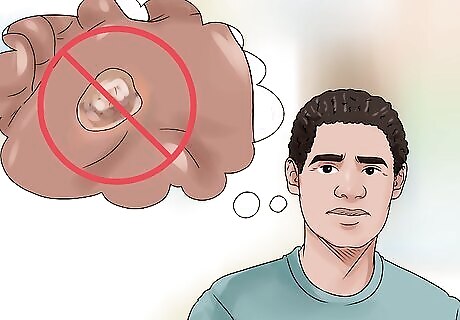
Eliminate the source of friction. The most common cause of corns and calluses on the feet is something causing irritation, pressure, or friction in the same spot. By eliminating the source of the friction, you can prevent corns and calluses from forming.
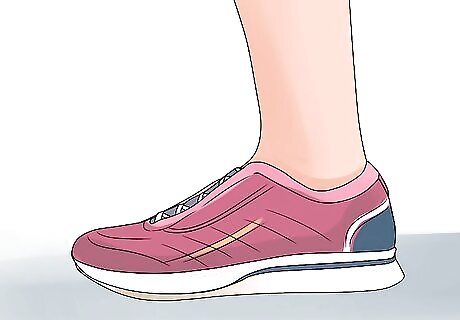
Wear shoes that fit properly. Shoes that do not fit can rub against your toes or cause your foot to slide inside the shoe. Be sure your toes have plenty of wiggle room inside your shoes. Corns develop along the tops and sides of your toes, and can be due to wearing shoes that do not give your toes enough room. Repeated rubbing or irritation caused by shoes that do not fit properly are a major cause of corns of calluses. Tightly fitting shoes and shoes with high heels that cause your fit to slide forward can cause corns and calluses to develop. Calluses develop when the bottom or side of the foot slides against a part of the shoe that is irritating, or slides inside of shoes that are too large.
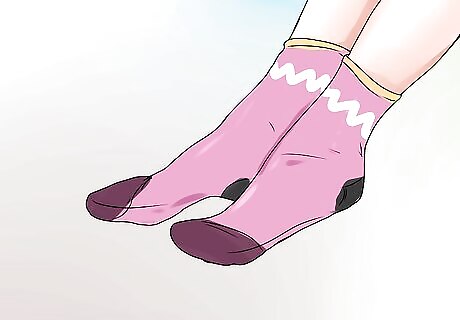
Wear socks. Going without socks can cause your feet to experience friction and pressure from your shoes. Always wear socks to prevent the friction and pressure. Especially in shoes that are designed to wear socks, such as athletic foot wear, heavy work shoes, and boots. Be sure your socks fit properly. Socks that are too tight can squeeze your toes causing unwanted pressure and friction. Loosely fitting socks can slide down on your foot while in the shoe and contribute to added friction and pressure on areas of your foot.

Apply protective coverings. Use pads placed on top of the areas where the corns develop, between your toes, or along areas where the calluses form. Using pads, sections lamb’s wool, or toe separators can help to reduce the friction and pressure along your toe or foot area where the corns and calluses are located.
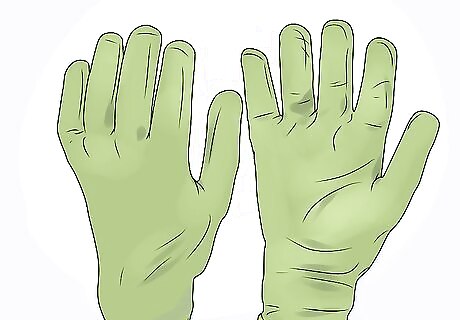
Wear gloves. Calluses form on your hands at the areas of greatest friction. In many cases, calluses on the hand are welcomed. One example involves people that play musical instruments. Guitar players, for instance, appreciate the calluses that form on the tips of their fingers. This helps them to play their instrument without pain. Another example is athletes that lift weights. The calluses that form on their hands can help them to grasp and manipulate the bars used in weight lifting.
















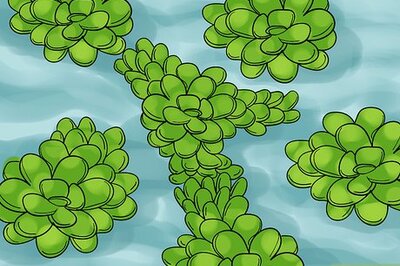

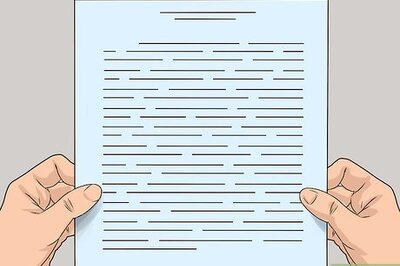
Comments
0 comment